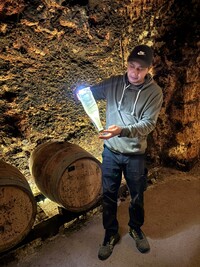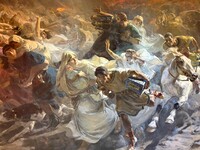By Alison Ramsey
Madrid's city center offers opportunities to study famous artworks by Goya, Velazquez and El Greco at the Prado Museum; stroll the landscaped lawns in beautiful Retiro Park; and climb the grand staircase to luxurious halls and the Royal Collections Gallery in the Royal Palace. But even more awaits just outside the city's epicenter. Easy day trips from central Madrid, Spain, introduce cultural experiences that heighten understanding and appreciation of Spanish art, architecture and history.
Colmenar de Oreja: A one-hour drive southeast of Madrid proper leads to the town of Colmenar de Oreja and the Ulpiano Checa Museum, a treasure-trove for art- and history-lovers. Born in Colmenar de Oreja, Ulpiano Checa (1860-1916) studied at the Royal Academy of Fine Arts of San Fernando in Madrid, later earning international recognition and numerous awards for his paintings, sculptures and posters.
Especially gifted at illustrating horses, Checa's dramatic chariot-race paintings influenced the set design and cinematography used in the 1959 "Ben-Hur" film that starred American actor Charlton Heston. The dynamic flow and emotions expressed in each of Checa's paintings are a marvel, and this museum allows visitors to immerse themselves in some of his masterpieces. Independent tour guide and art aficionado Mauricio Macarron said, "The way (Checa) was able to transmit movement and energy through his paintings is what made him famous."
In Colmenar de Oreja, take part in the popular Madrid enoturismo (wine tourism) with a tour and tasting at Bodegas Jesus Diaz e Hijos winery. This includes a trip to the underground limestone caves excavated by 16th-century Franciscan monks during the property's beginning as a convent. When the convent was disentitled and sold as a private estate, it became a factory for giant clay wine jars and was later transformed into the current-day winery. Explore the artisanal production process and see the massive heritage-protected clay jars, followed by a tasting of reds and whites. Try quality sparkling wine made with the macabeo grape. While the brand's other wines are readily available in area supermarkets, only 1,200 bottles of this sparkling variety are produced per year, and it is only sold at the winery.
Chinchon: Just a 10-minute drive northwest from Colmenar de Oreja, the neighboring town of Chinchon is known for its circular main "square" used for centuries as a bullring and Spanish theater. This Plaza Mayor is surrounded by apartments, with 234 balconies for viewing. The town's main church, Church of Nuestra Senora de la Asuncion, features artwork by Ulpiano Checo, including his enormous fresco of St. Christopher, the patron saint of travelers. Tourists are known to step into the church for a quick boost of protection and to admire Francisco de Goya's gorgeous "The Assumption of the Virgin" painting above the main altar.
Stop at Parador de Chinchon — a former Augustinian convent turned hotel — to wander beneath fruit trees and listen to birdsong in the blossoming garden. Tour the rooms and see where the cast and crew of Wes Anderson's 2023 "Asteroid City" were housed for several months during filming. Dine at El Convento or El Bodegon restaurants to sample a traditional Madrid stew and sip the strong, flavorful anisette digestive local to Chinchon.
San Lorenzo de El Escorial: Northwest of Madrid's city center (and 1,000 more feet above sea level), the Sierra de Guadarrama mountains house the largest Renaissance building in the world. The popular tourist destination Royal Monastery of San Lorenzo de El Escorial can be reached in a pleasant 45-minute car, train or bus ride from Madrid through the countryside (past fields where bulls are raised for bull-fighting). Green buses at several large bus stations make regular runs to bring visitors here from downtown. The UNESCO World Heritage Site monastery on the southern end of Mount Abantos is a prime place to explore the history of the Spanish Golden Age and the reign of Philip II. In this scenic location, King Philip commissioned the great basilica in Spanish Renaissance architectural style.
Bibliophile King Philip's magnificent main library is often listed as one of the best in the world, filled with original architect-designed wooden bookshelves, rows and rows of gold-tipped books, relics, globes and scientific artifacts. Built in only 21 years, the library's construction was an extraordinary feat, and seeing its lavish painted arched ceiling is in itself worth the trip.
Spanish painter Diego Velazquez's important "Joseph's Bloody Coat Brought to Jacob" painting resides in the monastery, depicting the moment when Joseph's brothers falsely report that Joseph has died and hold out his bloodied colorful coat as proof. Macarron said the painting was meant to hang alongside "Apollo in the Forge of Vulcan," currently being displayed at the Prado Museum. Both were painted during Velazquez's first trip to Rome, are a similar size, have a confrontational theme, and show the artist's mastery of vividly portraying human emotions and proportionately depicting the male form on canvas.
The Pantheon of Kings royal burial chamber is found directly below the monastery's main basilica. Descend an ornate arched staircase to the chilly octagonal mausoleum containing 26 black marble sepulchers labeled with gold tablets indicating where the House of Habsburg and House of Bourbon kings and queens are entombed.
In and around Madrid are richly unique sights blending art, natural beauty, and history to inspire and enthrall. Explore the city center, but be sure to venture out for unforgettable countryside culture.
WHEN YOU GO
Stay in Madrid at the centrally located Hotel Villa Real for easy access to the inner-city sites, such as the Prado Museum, Retiro Park, Thyssen-Bornemisza National Museum, Royal Palace of Madrid and Gran Via high-end shopping street: hotelvillareal.com/en.
For more information about Madrid: visitmadrid.es/en.



Alison Ramsey is a freelance writer and photographer. To read features by other Creators Syndicate writers and cartoonists, visit the Creators Syndicate website at www.creators.com. COPYRIGHT 2025 CREATORS.COM
The magnificent library at the Royal Monastery of San Lorenzo de El Escorial houses medieval books, relics and a beautiful arched ceiling of gold-embellished frescoes. Photo courtesy of Alison Ramsey.






View Comments